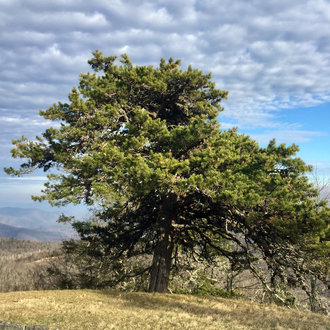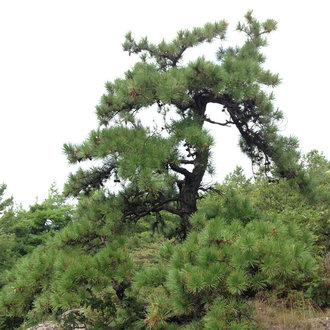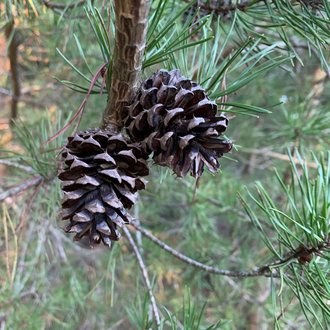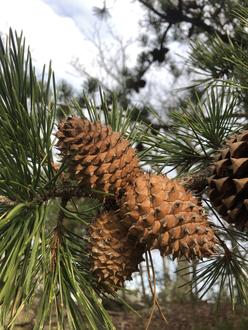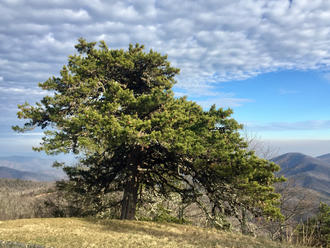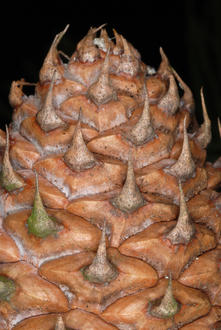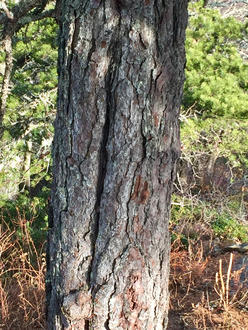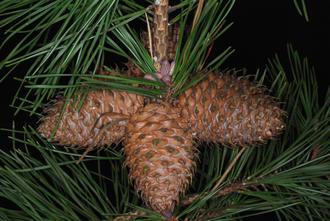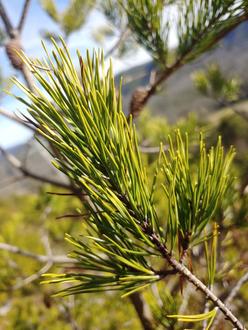Table Mountain Pine (Pinus pungens Lamb.)
↑Summary
A scrubby pine of exposed, rocky sites, mostly found at high elevations in the Appalachians.
↑Similar Plants
↑Habitat
Mostly restricted to steep, rocky ridges in the Appalachians. Mostly limited to south- and west-facing slopes at from 1,000-4,000 ft (305-1,220 m.) Typically grows in areas with exposed rock and shallow, acidic soil; also found in deeper soils with a high rock content. Restricted to well-drained to excessively dry sites.
Forms stable population on harsh sites unsuitable for other species, but also functions as a pioneer species on slightly richer sites following fire or other disturbance, where it is eventually replaced by other species, such as oaks and understories of mountain laurel. Populations are maintained by regular fires on some such sites, but this species can also reproduce and achieve dominance in the absence of fire on the driest, rockiest sites.
A few isolated populations can be found at higher elevations, at lower elevations along major rivers, and at the margins of mountain bogs.
↑Life Cycle
The conditions for successful establishment of seedlings of this species are not well-known, and may vary considerably by site, due to this species occurrence in different habitats.
However, seedlings tend to require open conditions and do not establish in areas with dense litter.
Although adult trees are drought-tolerant, young seedlings are highly susceptible to summer drought. Seedlings are intolerant of shading and competition from other plants.
Growth is slow. Trees typically develop a taproot in a rock crevice to anchor themselves, and also develop spreading lateral roots which seek out pockets of deeper soil, both seeking nutrients and further sites to grow deep roots for anchoring.
Trees are wind-pollinated.
Seed production begins around 5-7 years of age. Seed production is relatively steady. Cones remain closed on many trees, with many being serontinous, only opening in response to fire or extended hot weather. However, serotiny of cones varies considerably among different populations and individuals, with some cones opening immediately, and others remaining closed for 5-30 years. Cones open and shed their seed irregularly, but total amount of seed distributed tends to be relatively consistent from year to year.
Closed cones form an aerial seed bank; seeds remain viable for an average of 9-11 years, but some remain viable as long as 30 years. Once released, seeds typically germinate or die and there is no seed banking in soil.
Trees can resprout from the base, following being top-killed. This species can be severely damaged by ice storms.
Mature trees are fire-resistant but can be top-killed by high-intensity fires.
↑Faunal Associations
The seed is an important year-round food source for the American red squirrel (Tamiasciurus hudsonicus), which opens the cones to eat the seed, especially when other seed sources are scarce.
This species is eaten by the native southern pine beetle Dendroctonus frontalis, which often kills this species off on sites where it is competing with oaks. The cones are eaten by the table mountain pine coneworm moth (Diorytria yatesi), which specializes on this species, the larvae boring through the cones and eating the inside of the maturing cones, effectively destroying the seed. The seeds are also eaten by the shieldbacked pine seed bug (Tetyra bipunctata).
↑Uses
This species has limited use for wood because of its small size, twisted shape, and tendency to be found on difficult-to-access sites.
↑Related Plants
Closely related to shortleaf pine (Pinus echinata) and pitch pine (Pinus rigida), both of which overlap with this species in range and are sometimes found in the same habitats. Hybrids with both species may occur.
↑Links & External Resources
• Table Mountain Pine | The Wood Database (About This Site)
• Table Mountain Pine | Fire Effects Information System (FEIS) (About This Site)
• Pinus pungens (Table Mountain pine) | USDA PLANTS Database (About This Site)
• Table Mountain Pine | Virginia Tech Dendrology Factsheets (About This Site)
• Table Mountain Pine | Silvics of North America (About This Site)
• Pinus pungens | Biota of North America Project (BONAP) (About This Site)
• Pinus pungens | NatureServe Explorer (About This Site)
• Pinus pungens | Flora of North America (About This Site)
• Table Mountain Pine | Maryland Biodiversity Project (About This Site)
• Pinus pungens Lambert (Table-mountain Pine) | Digital Atlas of the Virginia Flora (About This Site)



